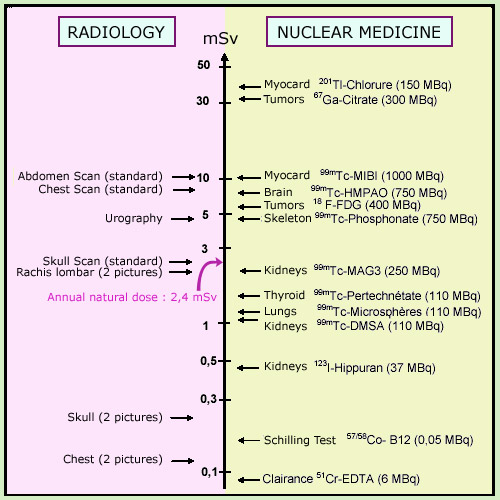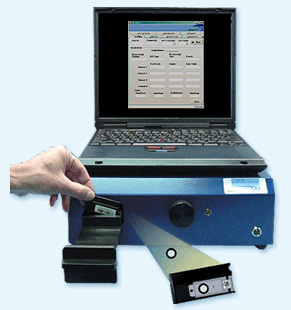Radiation doses in diagnostics
From simple radiology to PET scans and scintigraphy
Scintigraphy scans are by far the most common radiation-based medical tests, though they are not as widespread as X-ray diagnoses. In the OECD countries with higher levels of healthcare, the number of scintigraphy scans went up to 19 per 1000 people in the period between 1996 and 2000. By comparison, X-rays amounts to 920 per 1000 people in the same 4 years.

Doses in radiology and nuclear diagnostics
The above table compares the effective doses felt by an adult in radiology and diagnostic nuclear medicine.
© Institut Curie (Source Rapport S.F.P.M. N 19-2001, Claude Touzery et al)
At this level of 19 scintigraphy scans per 1000 people each year, there is a good chance that every inhabitant of a developed country will undergo a nuclear medical test in his lifetime. Positron emission tomography, however, is still relegated to a marginal role in this field, owing to the bulky equipment needed for its use.
The risks of radiation exposure posed by such ‘nuclear screenings’ are negligible when compared to their potential benefits. As in all situations where radioactivity is involved, however, precautions are at a maximum and so the number of examinations is kept to a minimum. Though the doses absorbed can vary considerably between tests, they are generally comparable to those absorbed in the course of the more common X-ray scans.
The X-ray radiographies or scans mentioned above all involve radiation whose sources are external to the body, whereas exposure resulting from a tracer located inside the body is referred to as internal. The radioisotopes which are administered usually have very short biological half-lives and as a result leave the body in the space of a few hours. The relevant effective doses (Medical Internal Radiation Doses) are measured by dosimeters and then modulated according to the patient’s age and sex.
radiographies or scans mentioned above all involve radiation whose sources are external to the body, whereas exposure resulting from a tracer located inside the body is referred to as internal. The radioisotopes which are administered usually have very short biological half-lives and as a result leave the body in the space of a few hours. The relevant effective doses (Medical Internal Radiation Doses) are measured by dosimeters and then modulated according to the patient’s age and sex.

Monitoring doses
In medicine it is necessary to monitor the doses of radiation absorbed during regular scans as well as in radiation therapy. OSL (Optically Simulated Luminescence) dosimetry techniques allow for practical and convenient accurate measurements of radiation doses and are frequently used in hospitals. The reader, which is both compact and easy-to-use, allows for dose measurements immediately before and after an examination and can thus determine its effect.
© LCIE Landauer
Cardiac scintigraphies, using radioactive thallium, generates the higher doses among scintigraphies.
More : Doses with X-Rays and CT Scans
More : Doses Nuclear diagnostics
Other articles on the subject « Expositions in Medicine »
Doses (X-Rays, CT scans)
Exposures to radiations in diagnostic radiology The vast majority of diagnoses based on radiation[...]
Doses (nuclear diagnostics)
Nuclear medicine : doses in nuclear diagnostics Nuclear medicine examinations are performed only [...]
Doses with therapies
Radio and nuclear therapies: Doses are high but local Genuine nuclear therapies (brachytherapy, p[...]
Doses in Nuclear therapies
High local doses In nuclear therapy, the doses delivered to tumours amount to few tens of Grays. [...]